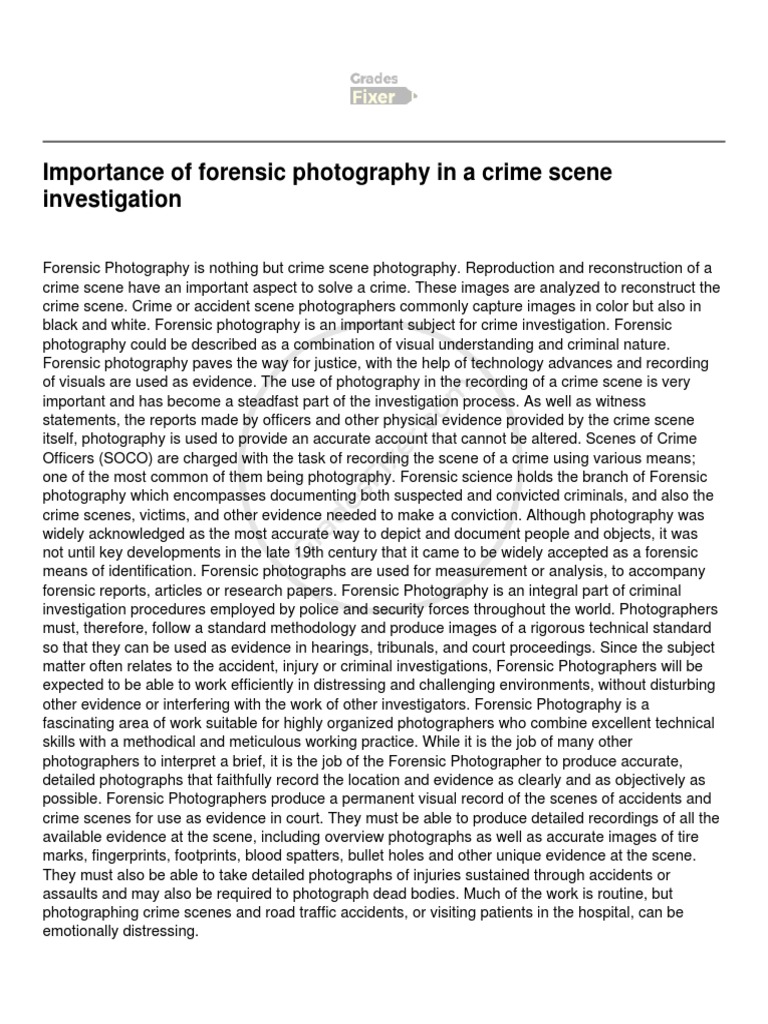The forensic examination of a crime scene is a meticulous dance between observation and interpretation, a symphony of science orchestrated to reveal the silent narratives embedded within the spatial tableau of a transgression. It’s not merely about collecting evidence; it’s about deciphering a cryptic language, translating the whispers of the past into a coherent account of what transpired. Think of it as being a skilled cryptographer, piecing together fragmented codes to unlock the truth. The process is multi-faceted, encompassing several critical stages, each demanding precision and a relentless pursuit of detail.
Securing and Isolating the Scene: The Initial Perimeter
The very first act in this forensic drama is containment. This involves establishing a secure perimeter, preventing unauthorized access, and safeguarding the integrity of the scene from contamination or disturbance. Imagine it as building a fortress around a fragile ecosystem, protecting it from external influences that could skew the natural balance. Crime scene tape serves as a stark visual barrier, demarcating the sacred space where the investigation will unfold. This initial perimeter is often expansive, erring on the side of caution to encompass potentially relevant areas. Only authorized personnel, meticulously documented, are permitted entry. The goal is pristine preservation, ensuring that the crime scene remains a reliable source of information.
Scene Assessment and Preliminary Survey: Mapping the Landscape
Once the scene is secure, a thorough assessment is conducted. This is akin to surveying a newly discovered land, mapping its contours and identifying key features. The lead investigator, along with the forensic team, systematically walks through the scene, noting the overall layout, potential points of entry and exit, and the location of any immediately obvious evidence. A preliminary theory of the crime begins to form at this stage, guiding the subsequent investigation. This initial sweep helps to define the scope of the search and establish priorities. The presence of biological fluids, weapons, or disturbed objects are carefully documented, forming the foundation for a comprehensive examination.
Documentation: Capturing the Ephemeral
Documentation is the cornerstone of any forensic investigation. It is the process of creating a permanent record of the crime scene as it existed at the time of discovery. This multifaceted process includes detailed photography, videography, sketching, and note-taking. Photographs are taken from multiple angles and distances, capturing the overall context as well as close-up details of individual pieces of evidence. Videography provides a dynamic perspective, allowing investigators to virtually walk through the scene. Sketches, both rough and scaled, provide a visual representation of the spatial relationships between objects. Notes meticulously chronicle observations, measurements, and any pertinent information. All these elements combine to form a comprehensive and irrefutable record. The goal is to preserve a memory of the scene that can be revisited and analyzed repeatedly.
Evidence Collection and Preservation: Gathering the Silent Witnesses
The collection of evidence is a delicate art, requiring specialized techniques and meticulous attention to detail. Each piece of evidence is carefully documented, photographed in situ, and then collected using appropriate tools and methods to prevent contamination. Think of it as carefully excavating precious artifacts from an archaeological dig. Items are placed in sterile containers, labeled with unique identifiers, and sealed to maintain their integrity. The chain of custody, a detailed record of who handled the evidence and when, is meticulously maintained to ensure its admissibility in court. Common types of evidence include: biological fluids (blood, saliva, semen), fingerprints, hair and fibers, trace evidence (soil, glass, paint), weapons, and digital devices. The proper preservation of evidence is paramount, as it forms the basis for subsequent laboratory analysis.
Laboratory Analysis: Deciphering the Code
Once collected, the evidence is transported to a forensic laboratory for analysis. Here, scientists with specialized expertise employ a range of techniques to extract information from the evidence. DNA analysis can identify individuals with incredible precision. Ballistics analysis can link a bullet to a specific firearm. Trace evidence analysis can identify the source of a particular material. Toxicological analysis can detect the presence of drugs or poisons. The laboratory is a nexus of scientific inquiry, where sophisticated instruments and rigorous protocols are used to unlock the secrets held within the evidence. The findings from the laboratory are then compared to other evidence and used to reconstruct the events of the crime.
Reconstruction: Piecing Together the Puzzle
The final stage of the forensic examination is reconstruction. This involves synthesizing all the available information – from the crime scene, laboratory analysis, and witness statements – to create a coherent narrative of what transpired. It’s like assembling a complex jigsaw puzzle, where each piece of evidence represents a fragment of the overall picture. Reconstruction involves analyzing blood spatter patterns, trajectory analysis, and other forensic techniques to determine the sequence of events, the positions of the victim and perpetrator, and the potential motive for the crime. The goal is to provide a clear and compelling account of what happened, based on scientific evidence.
In conclusion, the forensic examination of a crime scene is a complex and multifaceted process, requiring a blend of scientific expertise, meticulous observation, and unwavering dedication. It is a pursuit of truth, a quest to uncover the hidden narratives embedded within the physical landscape of a crime. It’s a testament to the power of science to shed light on the darkest corners of human behavior.










Leave a Comment